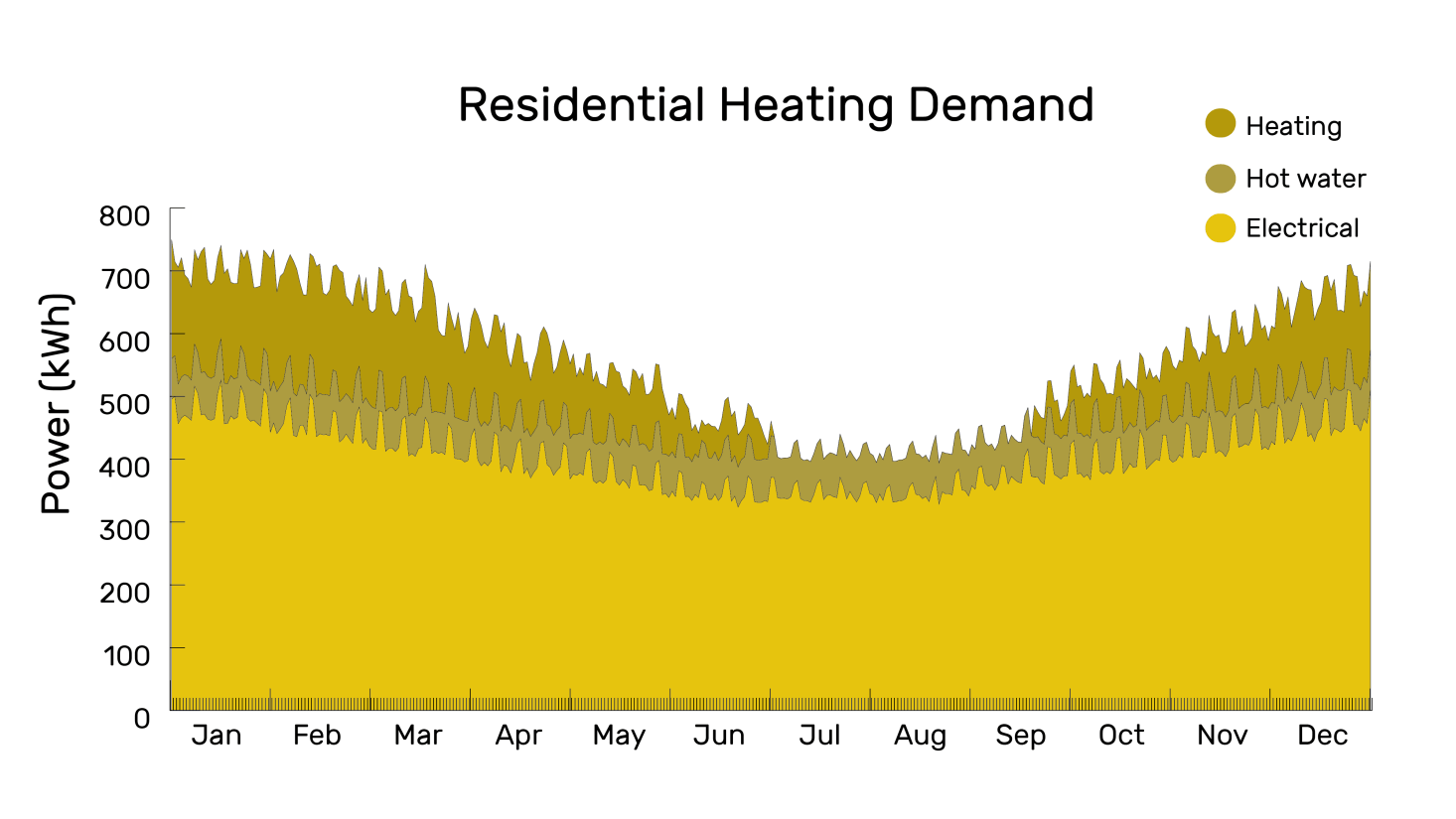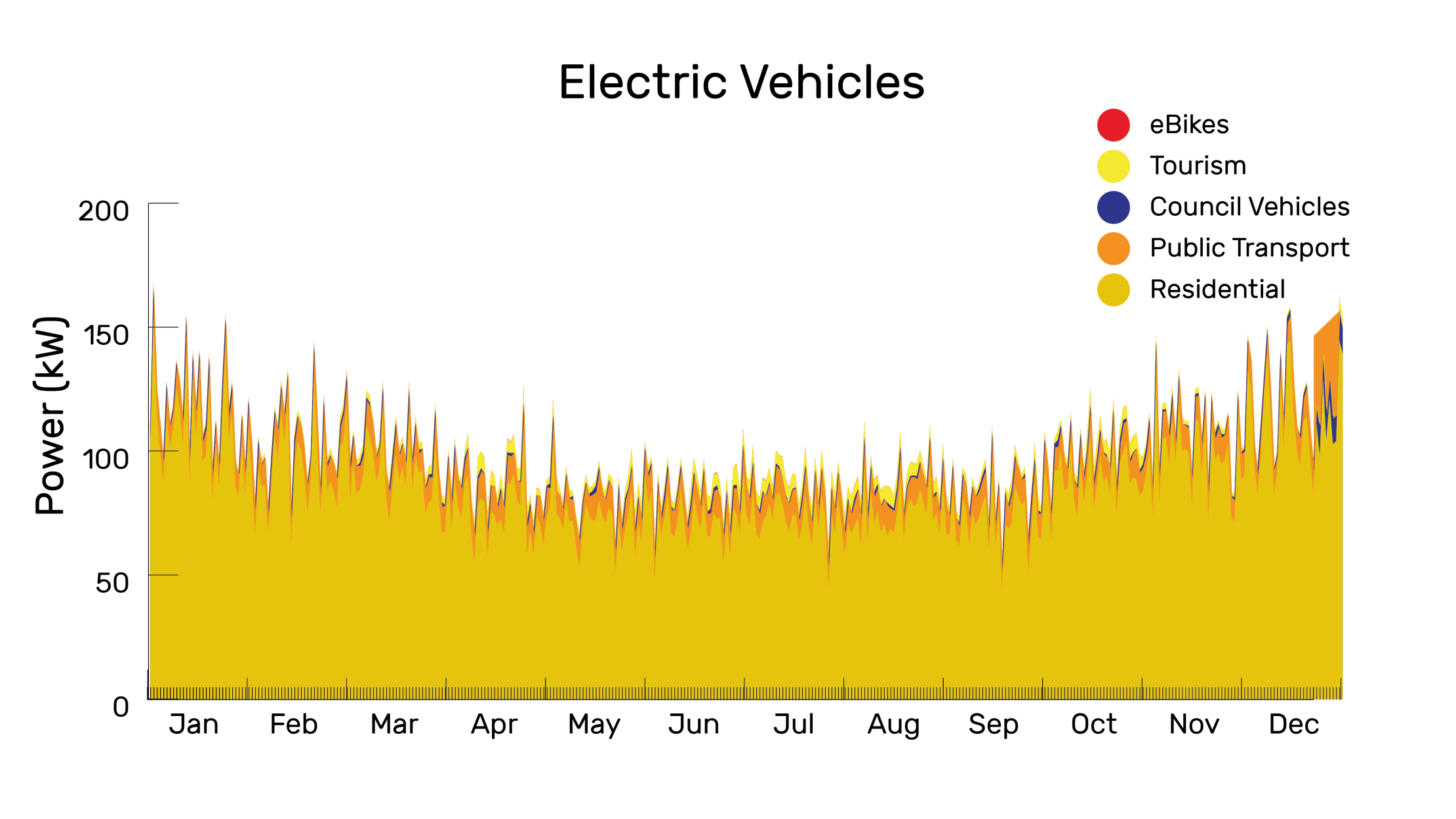
Addressing the current system, residential dwelling demand and transportation has been modelled for reduction
Europe faces the challenge of not only promoting new energy efficient buildings but also encouraging the upgrading of an aging building stock to reduce CO2 emissions [9]. The UK has some of the oldest and least energy efficient buildings in Europe [10]. Many of UK’s residential dwellings were built during a time when materials and technologies encouraged breathability of a building [11].
From the EPC data acquired during the initial energy audit of Kinlochleven it has been determined that a semi-detached house is the most common dwelling type. This analysis examines how a typical semi-detached house in Kinlochleven could reduce its energy consumption by implementing EnerPHit standards. These energy savings were then scaled to the other dwelling types to get the village's total residential demand.
A typical Kinlochleven semi-detached dwelling has been modelled using ESRU's ESP-r, a dynamic software tool (see video below). The model was created using similar building materials to that of typical Kinlochleven dwelling. ESP-r allows modelling of heat transfer between zones and generates space heating demand profiles that can be used in demand and supply matching. The model has occupant schedules, a basic heating control system with an efficiency of 80%, and casual gains consistent with their zone type.
Modelling the semi-detached house in Kinlochleven shows that the housing stock requires significant changes to the building materials and their construction in order to reduce space heating energy demand. The proposed changes are outlined below along with a map showing residential dwellings in Kinlochleven:
It's assumed that the heating system after installation will have an efficiency of 95%.
| Proposed Change | EnerPHit Standard Required | ESP-r Model Value | Comments |
|---|---|---|---|
| External Cladding (W/m2K) | < 0.15 | 0.10 | Insulation of 250 mm with a thermal conductivity of 0.025 W/m2K |
| Internal Insulation (W/m2K) | < 0.35 | 0.19 | Insulation of 150 mm with a thermal conductivity of 0.025 W/m2K |
| Roof (W/m2K) | < 0.35 | 0.13 | Insulation added to the roofing structure and integrated PV |
| Windows (W/m2K) | < 0.8 | 0.80 | Triple glazed windows with low emmisivity coatings |
| Doors (W/m2K) | < 0.85 | 0.85 | Doors installed to EnerPHit standard |
| Air Tightness (AC/h @ 50 Pa) | 0.6 | 0.6 | Air tightness of the building in line with EnerPHit standards |
| Ventilation with Heat Recovery | > 75% | 85% | Model retains 85% of heat lost during ventilation |
The proposed design installs an air source heat pump (ASHP) to every household. A previous study looked at water source heat pumps in the village. ASHPs were chosen for this project as some houses in Kinlochleven already use these to heat their homes.
ASHP's have the ability to be a direct low-carbon replacement for conventional space heating sources when coupled with renewable energy sources [13]. ASHP use air from the atmosphere to heat water which is pumped through the house and makes greater use of energy efficiencies as they can generate multiple units of heat energy per unit of electrical energy consumed. This would allow the reduction of hot water heating demand by a factor of more than 3.
Utilising the proposed changes reduces the space heating demand of a semi-detached house to 20 kWh/m2. This is a significant reduction from the original design of 220 kWh/m2. The semi-detached total demand has been reduced to 120 kWh/m2 which includes space heating, hot water and electrical. This is in line with EnerPHit's criteria. The modelled combined peak demand of the village's dwellings is 1.6 MW. It is proposed that the electrical demand reduction is achieved through the implementation of energy efficient appliances. This total factor saving has been extrapolated to the other dwelling types of Kinlochleven.
The reduction in residential dwellings from the current system is shown in the graph above and the total demand profile for residential dwellings in Kinlochleven can be found below.

The reduction of CO2 emissions was a primary aim of this project and so transport was a key consideration. In the, UK fossil fuels from transport account for 32% of total CO2 emissions [14]. The Kinlochleven Community Trust have already taken steps towards this all-electric future and are currently in the process of installing two EV charge points (see picture below) in the village to encourage tourists to spend time in the village and make the most of this beautiful location.
The hourly demand profile for privately owned vehicles was generated from national aggregated data, recorded over a year to account for seasonal variations. It was assumed there was no change in charging or driving habits.
The number of vehicles was estimated from Scottish Transport Survey (STS) [15] and Scale of Multiple Deprivation (SMID) [16], suggesting 359 privately owned vehicles in the village. To determine the type of vehicles to model, the most popular vehicles from 2018 were extrapolated to provide estimated electrical energy demand.
The seasonal nature of the tourism charging demand is complex. New campervan hook-ups and potential for electric campervans were considered. A “worst-case scenario” was assumed in terms of charging requirements. All estimated tourism traffic was modelled as an electrical demand as there is no fuel station in the village. This is in line with the Scottish Government's plan to stop the sale of fossil fuel vehicles by 2032.
The profile comprises three components: a base sinusoidal curve to mimic the general trend of seasonality, an increase for busy weekends in the village (including large events that it plays host to) and a degree of randomness to simply model the daily variances. This was then diversified in the same way as used for the private vehicle demand.
The following map shows all locations where charge points could be installed, this includes residential dwellings and public car parks. The chart below the map shows the demand profiles for electric transport.

Two council vans, the Royal Mail van and a bin lorry were included in the modelling of electric transport demand. Demand for electrified school and service buses was modelled, with one vehicle charging in the village during the day. The other public transport vehicles were assumed to charge in the village overnight.
Whilst there are no existing eBikes in the village, it was targeted as a possible addition for tourism, allowing for increased ease of access to the village and the surrounding hills. This could ease access to Mamores Lodge which is due to undergo redevelopment and may bring an additional income stream for the village by means of an eBike rental scheme. eBikes have very small batteries in comparison to other vehicle types considered, at approximately 0.5 kWh, but were modelled for completeness.
At present, one of the most significant problems in EV development is the shortage of charging infrastructure [17]. The proposed solution addresses this problem for private, tourist and public transport. The switch from internal combustion engines results in efficiency improvements, reducing the energy demand by a factor of 4. This yields an annual total demand for the year of 0.88 GWh.